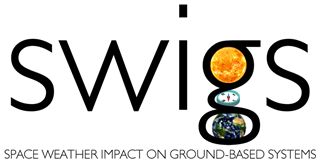Space Weather Impact on Ground-based Systems (SWIGS)
In May 2017 the Geomagnetism Team kicked-off a major space weather project called Space Weather Impacts on Ground-based Systems (SWIGS), at a meeting in Edinburgh.
SWIGS has been a four year NERC-funded consortium of ten institutes, 21 researchers and several post-docs, under the Highlight Topic funding stream.
SWIGS represented a major investment by NERC in space weather and the consortium led by BGS comprises many of the major UK players in the subject. SWIGS pre-dates and has therefore helped shape a subsequent major UKRI investment in the SAGE project (2021-2024).
One novel aspect of SWIGS has been the bringing together of space physicists and geophysicists studying the solid Earth and upper atmosphere. Together with project partners in the North America, Europe, New Zealand and China, as well as industry stakeholders, we have developed our understanding of how space weather and geomagnetic activity drives electric fields in the Earth and quantified the impacts of this on power grids, pipeline and rail networks
Background
Severe space weather is known to pose a significant hazard to ground based technologies, such as electrical transmission systems, pipelines and railways.
Geomagnetically Induced Currents (GIC) are a documented hazard to the continuous, safe and efficient operation of high voltage power transformers, as well as a cause of increased corrosion rates in metal pipelines and a disruptor of safe signal operations within railway networks. Estimates of potential economic loss from severe space weather run into billions of dollars per day. This is a result of our interconnected society's increasing dependence on various technologies, including electrical power, and the impact that, for example, power loss can have on economic and other activities within and between nations.
Project Goals and Achievements
During SWIGS we have developed a better physical understanding of electromagnetic fields and currents in near Earth space and in the upper atmosphere, through focussing on the couplings between the Solar Wind and geo-electromagnetic processes on the ground and in the ionosphere and magnetosphere (under Work Package 1).
SWIGS researchers have also made surface electric field, subsurface conductivity and GIC measurements - creating legacy data sets - to validate existing and new models and to provide estimates of uncertainty in estimated GIC, for example at the transformer level (WP2).
Industry requires better and timely forecasts of GIC and SWIGS has sought to improve forecasting of Earth environment and solid Earth processes and extremes (WP3).
This has led to a new generation of solid Earth and space environment models that quantify how space weather, rapid magnetic variations, sub-surface conductivity and surface electric fields impact surface conducting infrastructures such as the National Grid electrical and pipeline networks (WP4).
Each of the WPs has a lead (bold, below) who has worked with BGS to manage deliverables, reports, meetings, outreach, and interaction with project partners and with an industry stakeholder advisory group (WP5). WP1-WP3 have made the scientific advances that has fed through WP4 to deliver impact.
- WP1: Magnetospheric-Ionospheric Sources (MIS) of GIC (BAS, RAL, UCL)
- WP2: Solid Earth Response to MIS (BGS, Edinburgh, Southampton)
- WP3: Forecasting MIS and GIC processes (BAS, BGS, Imperial, Lancaster, Leeds, RAL, Reading)
- WP4: Infrastructure Impact of GIC (BGS, Lancaster, RAL)
- WP5: Management of Outputs, Reporting, Coordination and Outreach (BGS, WP leads)
Investigators
Principle Investigator: Dr Alan Thomson1
Co-Investigators: Dr Ciaran Beggan1, Prof Jeremy Chittenden5, Dr Mark Clilverd3, Prof Malcolm Dunlop6, Dr Emma Eastoe4, Dr Jonathan Eastwood5, Dr Robert Fear7, Dr Mervyn Freeman3, Prof Mike Hapgood6, Dr Andrew Kavanagh3, Dr Phil Livermore8, Prof Mike Lockwood9, Dr Jon Mound8, Dr Matthew Owen9, Dr Colin Forsyth10, Dr Gemma Richardson1, Dr Fiona Simpson7, Prof Kathryn Whaler2, Prof Jim Wild4
1. British Geological Survey, 2. University of Edinburgh, 3. British Antarctic Survey, 4. University of Lancaster, 5. Imperial College, 6. Rutherford Appleton Laboratory, 7. University of Southampton, 8. University of Leeds, 9. University of Reading, 10. University College London
Contact
For more information please contact Dr Alan Thomson.

- Global Geomagnetic Models
- Space Weather and Geomagnetic Hazard
- High-frequency magnetometers
- Schumann Resonances
- Geoelectric field monitoring
- Space Weather Impact on Ground-based Systems (SWIGS)
- SWIMMR Activities in Ground Effects (SAGE)
- Geomagnetic Virtual Observatories
- Quantum magnetometers for space weather
- Magnetotellurics
- Publications List




